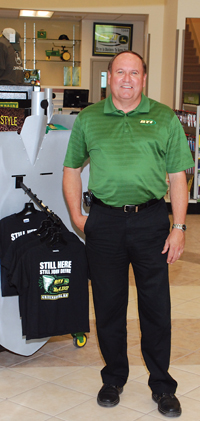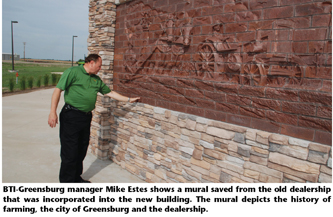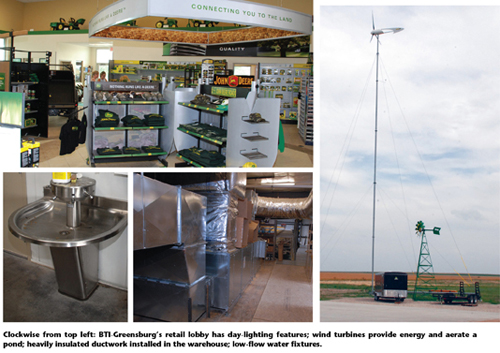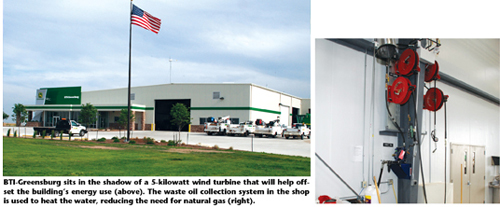

Dealership flattened by tornado re-emerges as a state-of-the-art ‘green’operation and a model for other dealers.
By Lynn Marcinkowski Woolf, Contributing Writer
Mike Estes, manager of BTI-Greensburg, stands in the rebuilt dealership’s retail lobby. “Two thousand people attended our grand opening,” he says. “It was phenomenal.”
Consider this timeline: On May 4, 2007, a 2-mile wide, EF-5 tornado destroys the BTI-Greensburg John Deere dealership — and 95% of the city of Greensburg, Kan.
The next day, nearly 100 customers help the dealership team clean up. Six weeks later, the dealership is supporting farmers during wheat harvest, operating out of 100-by-80-foot shed. Two years later, BTI-Greensburg celebrates its grand opening as a “green” showplace for Deere — and for facilities of any industry.
“Two thousand people attended our grand opening. It was phenomenal,” says Mike Estes, manager of BTI-Greensburg and co-owner of BTI, which owns four Deere dealerships. “You just can’t thank people enough.”
The dealership achieved a Leadership in Energy and Environmental Building Design (LEED) Platinum rating. This is the highest level awarded by the U.S. Green Building Council. LEED provides building owners and operators a framework for green building design, construction, operations and maintenance. No other metal pre-fabricated building has achieved LEED status, let alone platinum status. BTI also won the Governor’s Award of Excellence, the state’s top business honor, in 2009.
“We’re taking John Deere Place to another level. We’re notching it up,” says Estes, referring to the company’s dealerships that incorporate a design style and retail concept.
The key goal was to save 38-42% in energy costs, as well as incorporate other sustainable features. Energy modeling showed that annual energy costs for a similar building, built to standard code, would run about $47,000 per year. BTI’s annual bill was projected at $24,000, thanks to energy conservation measures and less purchased electricity.
This is how the systems work for the 28,000 square-foot facility, which include natural lighting, improved insulation, efficient heating, ventilation and air conditioning and wind power.

Natural Lighting. Natural daylight is critical to the dealership’s energy savings. Twelve Solatube-brand daylight devices provide the majority of the retail lobby light. In other areas, 23 Baylight-brand skylights illuminate the service shop, parts department and wash bay. High-efficiency lights and luminaire fixtures fill in when daylight is not sufficient.
“In the old building, if the electricity went off, it was dark and you were done working,” says Estes, referring to the benefits of daylights. “It’s a huge energy saver that the lights turn off on their own.”
Watt Stopper-brand sensors turn lights on and off in offices and balance electric light with daylight. In fact, notes are posted near light switches to remind people not to turn off the lights.
Art Kuehler, president of HASTCO Construction, the design/build general contractor for the project, says other dealerships can — and should — consider daylighting to save on energy costs, either in a new facility or when remodeling. “New skylight designs conform to a rooftop system,” he says. Sensor-balancing systems can be added in to existing buildings as well.
Improved Insulation. The facility exceeds insulation standards in all areas, to help with the quest to save energy costs. The wall panels are R-20, two times the standard, and the kind typically used in refrigerated warehouses. This helps eliminate the “thermal breaks,” or heat loss, seen in metal buildings. Garage doors are R-14 insulated panels, 20 times better than the standard practice. The roof has R-38 insulation, two times better than the standard. R-3.8 insulation is under the slab floor to minimize heat loss.
“We’re pushing better insulation with all our facilities,” says Kuehler, who has numerous dealership projects under way. “With one of our jobs, we’re even using R-25 in the walls.”
He says there are retro-fit insulation systems that dealers could consider for existing facilities, if poor insulation is a concern.

Efficient HVAC. Since it is new construction, BTI-Greensburg was able to incorporate a Viega radiant floor heating system in the concrete slab of the warehouse, shop and other areas. Warm water circulates through the lines in the slab and heat radiates out from the floor. BTI uses recycled waste oil to heat the water, reducing the need for natural gas. Estes says they accumulate most of the oil in the summer, so they did have to rely more on natural gas in the first few months.
Kuehler highly recommends in-floor heating for any new facility. “It is much more energy-efficient over heating just the air — which leaves every time a door opens.”
A high-efficiency Trane variable air volume system (VAV) heats the retail lobby and offices and provides cooling. Water heated with waste oil for the radiant system also runs through the VAV’s heat exchanger. Motion detectors and individual controls help minimize energy use.
“Part of LEED is to have comfort zones with multiple controls,” Kuehler says. “The VAV system provides that capability.”
Again, retrofitting an existing forced air system with individual controls is a possibility for those concerned about their dealership’s indoor environment, says Kuehler.
The Trane system is linked to an online reporting and monitoring system. BTI even makes the information publicly available through a touch screen in the retail lobby. Now, visitors to BIT’s web site will be able to access the touch screen information, which also describes all the green systems.
Wind Power. BTI is taking full advantage of Kansas’ strong winds. A 5 kilowatt wind turbine was installed in the summer of 2008 to provide power during construction, and a 1.8 kilowatt turbine was later added. Together, the turbines are expected to offset about 8% of the building’s energy use.
“Greensburg has now enacted an ordinance to allow alternative energy to connect in,” says Estes. “We’ll have a net billing system, where if we provide more than we use it will come off our next month’s bill.”
Estes and his family’s corporation have also launched BTI Wind Energy, a distribution network that sells Endurance turbines to hospitals, schools, government facilities and others. In just 1 year, they’ve sold more than 200 units in the U.S. and Canada. They have dealers in 32 states and six Canadian provinces. “Our network is out there working and selling every day,” he says.
The Estes family has also been instrumental in the new Greensburg Wind Farm. The farm is expected to provide 100% of the city’s power from 10 1.2 megawatt wind turbines. Energy production is expected for early 2010. Development partners are the city of Greensburg, the Kansas Power Pool and John Deere Renewables.
A new BTI Wind Energy building, located adjacent to the dealership, will houses BTI staff, as well as Deere and Endurance technicians.
“We’ll be bringing in technicians in from all over the U.S. — and the world,” Estes says.
Kuehler says that wind energy was right for this Kansas dealership, but may not be a fit for others. “Look at what area of the country you are in and what’s available to you — wind, geothermal, solar,” he says. “Every dealership should consider creating a certain percentage of its own power.”
Sustainable features. In addition to conserving energy, BTI integrated sustainable features and practices to meet LEED requirements that include:
- Site
- Water efficiency
- Materials and resources
- Indoor environmental air quality
The site design focuses on minimizing disturbance, controlling erosion and other resource-friendly features. To limit heat in and around the site — the “heat island” — white roofing was installed and fly ash was mixed into the paving concrete, both of which help reflect the heat.
Kuehler says dealerships that are considering remodeling need to think about reflective roofing.
“Many dealerships that are 15 to 20 years old have roof issues,” he says, adding that incorporating reflective roofing and better insulation can go a long way to saving on energy costs.
BTI’s other site-design features include using recycled crushed concrete from the old dealership for graveled areas surrounding the facility. “We’re standing on the basements of Greensburg,” Estes says.
A run-off water collection pond helps irrigate drought-tolerant landscaping – native grasses, plants and trees. Even water from the dealership’s dynamometer drains into the pond. Another smaller wind turbine aerates the pond. Inside, waterless urinals and low-flow fixtures help control water usage.
Recycling, both during the building’s construction and afterward, helps meet LEED materials requirements. Some practices are simple, such as a workplace recycling plan. Others required more effort. For example, HASTCO looked for recycled building materials, such as BTI’s open steel warehouse mezzanine, which came from a steel supplier in Newton, Kan.
Indoor environmental air quality is maintained through a non-smoking environment, highly efficient air filters, personal heating and cooling controls, and carbon monoxide controls. Adhesives, woods, carpet and paint have low volatile organic compounds, or are low in emitting gases and vapors that could affect health.
Special parking for low-emitting vehicles and bike racks add to sustainability. “We don’t get many farmers biking in for parts,” says Estes. “But we may get bikers as tourism picks up in Greensburg.”

The Green Results
Estes says the business is seeing reduced energy bills. But he admits it’s early in the facility’s operation. “We are still in the shakedown phase, but I’m confident that the model is working.”
Estes says some ideas haven’t worked. For example, they had planned to use a corn boiler to supplement heat. “We had used a corn boiler in our old shop for a number of years. We just couldn’t find the right product for this kind of application.”
They’ve made other adjustments to accommodate a smaller facility, or smaller “carbon footprint.” The previous dealership had 44,000 square feet between 2 buildings. They’ve reduced some inventory, for instance, and a Stanley Vidmar-brand storage system houses parts in stacked drawers.
“We used to house parts in open bins, which were not space efficient,” Estes says. Bar coding helps track the location of parts. In the warehouse, a track-mounted forklift helps lift and stack heavy parts in the multi-level warehouse.
A Model for Other Dealerships
Estes says their green systems added about 7-9% to the building’s cost. He says his costs were higher than other green buildings because of LEED certification requirements.
“We wanted to pursue LEED to support Greensburg’s commitment to green building,” says Estes. The city hall and school have already achieved LEED platinum status. “We still had customers after the tornado. Without a city, we wouldn’t have employees,” Estes says.
He adds, “Not everything we did is appropriate for an existing dealer. But, a lot of dealers are in a growth mode. Dealerships are consolidating and a lot of facilities need to be updated.”
Dealers who don’t want to be LEED certified could still use the guidelines for additions or new facilities. Kuehler advises working with a LEED-certified expert to help uncover tax breaks to add to the energy savings. “If we can cut anybody’s energy costs by 30-40%, that is significant,” he says.
Estes says his dealership’s green initiatives also reflect the view of his customers.
“Farmers are some of the best conservationists in the world. Conservation is necessary because it protects their livelihood.”





